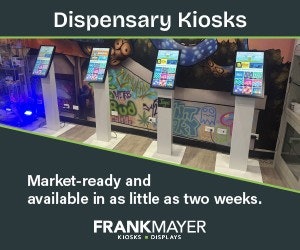
In the evolving landscape of cannabis retail, measuring a store manager's success transcends traditional metrics. It requires a careful balance between driving profitability and maintaining conscientious sales practices—a complex dance between business objectives and genuine customer care. And in that complex dance, data/metrics can serve as major guideposts to help focus on the right things and drive profits. But to ensure that proper focus and drive, the data you’re collecting and reviewing has to be the right data to support those goals.
Redefining Key Performance Indicators (KPIs) for Cannabis Retail Managers
- Sales Volume vs. Profitability: The cannabis industry has historically focused on driving topline sales. Many times, this has been at the expense of profitability. Effective management is signaled not just by the quantity of sales but by their quality—focusing on profitability that factors in costs, operating expenses, and margins on products sold.
- Basket Size: These metrics are crucial for assessing how effectively a manager boosts not only the volume of products sold, but how they are able to upsell to ensure a bigger basket.
- Promotion of Own Brands: Not every dispensary is vertically integrated or has the ability to create their own brands. However, those that do can take their cue from the grocery industry. Retailers like Kroger focus on their own brands as a way to increase profitability while maintaining stickiness with their consumers. With higher margins typically associated with store brands, the push for these products needs to be balanced carefully with customer preferences to sustain both profitability and satisfaction.
- Strategic Discount Management: Managers must navigate the thin line between using discounts to attract customers and maintaining the perceived value of their offerings, ensuring that discounts do not undercut the profitability or brand integrity. The race to the bottom is real. As an industry, we need to ensure that manage discounts appropriately – no more daily deals!
Leveraging Data Analytics for Strategic Inventory Management
Data has come a long way in the industry. Just a few years ago, it was challenging to find comprehensive market insights. While it still is not perfect, these tools have drastically improved. Utilizing advanced data analytics tools, such as point of sale (POS)/e-commerce systems and market insight platforms like Headset Bridge, is crucial for refining product assortment and optimizing demand planning. Assortment can also be analyzed and optimized using POS dashboards like Dutchie, FlowHub and Treez, e-commerce tools such as Mosaic & Dispense, and loyalty platforms like SpringBig and Alpine IQ. These systems provide valuable data insights, helping businesses track sales trends, understand customer preferences, and manage inventory effectively to enable:
- Optimizing Product Assortment: Analytics tools help pinpoint which products are performing well and which aren't, allowing managers to tailor their inventory to meet actual customer demand.
- Efficient Ordering: By analyzing data trends, managers can predict future sales more accurately, ensuring that they order the right amount of each product to meet anticipated demand without overstocking or stockouts. You can’t sell what you don’t have!
- Continuous Communication: It’s vital for store general managers, inventory managers, and budtenders to maintain regular communication. This ongoing dialogue ensures that everyone is aligned on inventory needs and can respond quickly to shifts in consumer behavior or supply issues.
The Imperative in Budtender Sales Tactics
In the unique retail environment of cannabis, where budtenders directly influence purchasing decisions, conscientious sales practices are paramount:
- Aligning Incentives With Integrity: The cannabis industry has seen a proliferation of budtender incentive programs. Brands are always looking for ways to capture the customer’s attention. It’s crucial that budtender incentives promote products based on customer needs rather than merely pushing brands that incentivize them. This approach ensures that recommendations are made with integrity, enhancing customer trust and long-term loyalty.
- Comprehensive Budtender Training: Ongoing education about product benefits and responsible selling techniques ensures that budtenders are well-equipped to advise customers accurately, matching them with products that genuinely meet their needs. Taking a budtender through a consumer path-to-purchase model (a decision tree that mirrors how consumers shop the category) will help them get the customer to the right product.
- Balancing Metrics With Ethics: Performance evaluations should integrate both quantitative sales goals and qualitative feedback, ensuring that budtenders are rewarded not just for the volume of sales but for the consumer satisfaction of those sales.
Effective Communication and Team Motivation
Creating a transparent and motivational environment is essential for managing a successful cannabis retail team:
- Team-Based Goals and Incentives: First and foremost, if the company is larger in size than one dispensary, it is important to ensure that the mission, vision, core values and high-level goals are communicated to the store team. From there, a general manager can ladder those goals down to actionable targets specific to the location. Additionally, encouraging collaboration through collective targets can enhance team dynamics and achievement, fostering a “we” vs. “me” atmosphere.
- Regular Feedback and Recognition: Constructive feedback and recognizing achievements should be regularly communicated, linking performance to broader business outcomes and responsible sales practices.
Tailoring KPIs for Marketing and Beyond
For marketing teams and other departments, aligning KPIs with broader business goals including profitability and customer satisfaction remains crucial:
- Marketing Spend ROI: This metric is vital for evaluating the direct profitability impact of marketing efforts and guiding budget optimization.
- Customer Lifetime Value (CLV): By focusing on cultivating long-term customer relationships, businesses can maximize the profitability and loyalty generated from each customer interaction.
Conclusion
In cannabis retail, the challenge for store managers is not just to meet sales targets but to do so in a way that respects the needs and well-being of their customers. This delicate balance between conscientious selling and profitability, enhanced by strategic use of data analytics, sets apart successful businesses in this highly competitive market.
Laurie Parfitt is the CEO of LKP Impact Consulting, LLC, a premier Fractional CMO firm that delivers comprehensive marketing solutions across the cannabis, CPG, and other highly regulated industries. With her extensive experience, Parfitt guides brands, operators, technology providers, and ancillary services through the complexities of digital marketing, social media, consumer insights, branding, activation, and public relations. Additionally, she is a Partner at Avicenna, a restructuring group specializing in the cannabis sector. She is a sought-after speaker, regularly sharing her insights at key industry events across the cannabis landscape.



























